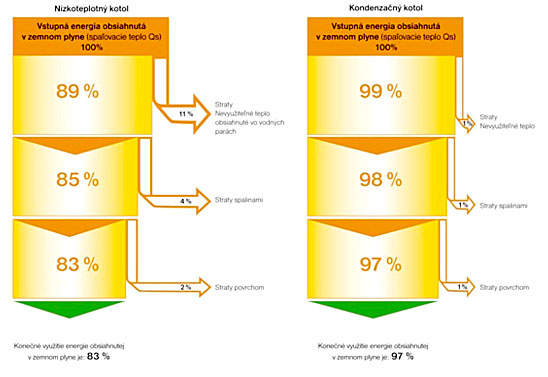Conventional boiler is designed to operate with dry exhaust gases. The lowest temperature of the water running to the boiler is limited to the value of 60°C. The exhaust gases temperature is usually in the range of 120 to 180°C. As connected to the heating system, the boiler must be fitted with a device ensuring a sufficiently high temperature of the water running to the boiler (return water) to prevent condensation of humidity from water vapour contained in exhaust gases and then the low-temperature corrosion of the heat exchange surface area at the point of entry of water into the boiler. The energy of natural gas burned in these boilers is used on about 80%.
Low-temperature boiler is designed to operate with dry exhaust gases, and can also work well with temperatures of the water running to the boiler in the range of 35 to 40°C. Under certain conditions, there is condensation in the boiler and the heat exchange surface area therefore has to be made of a corrosion-resistant material. They are mostly cast-iron sectional boilers. The exhaust gases temperature is usually from 90 to 140°C. Connection to the heating system can be direct without mixing fittings with a direct control of the boiler operation according to the outside temperature. Utilization of the energy content of the burned natural gas is around 83%.
Condensing boiler is purposely designed for condensation operations – directly in the boiler, there is condensation of humidity from water vapour contained in exhaust gases. The heat exchange surface area therefore has to be made of a material well resistant to corrosion. It is used stainless steel or an alloy of aluminium and magnesium. The condensate from the boiler has to be permanently discharged. By using the condensation heat, the gas consumption is reduced and the temperature of the inlet water to the boiler is not limited. The exhaust gases temperature is in the range of 40 – 90°C depending on the temperature of the inlet water of the heat system and also on the immediate use of the boiler. Because the exhaust gases temperature is low and it is not sufficient to create enough tension in the chimney and thereby to secure a safe transportation of the exhaust gases, there must be an air or flue gas fan in the condensing boiler. Exhaust gases entering the chimney are wet, the chimney therefore has to be of a structure resistant to moisture and also internal pressure. Condensing boilers due to its construction allowing the use of the condensation heat of exhaust gases are able to use the energy of the burning natural gas up to 97%.
Comparison of the utilization of energy contained in natural gas in low-temperature and condensing boilers (the real efficiency of boilers):
